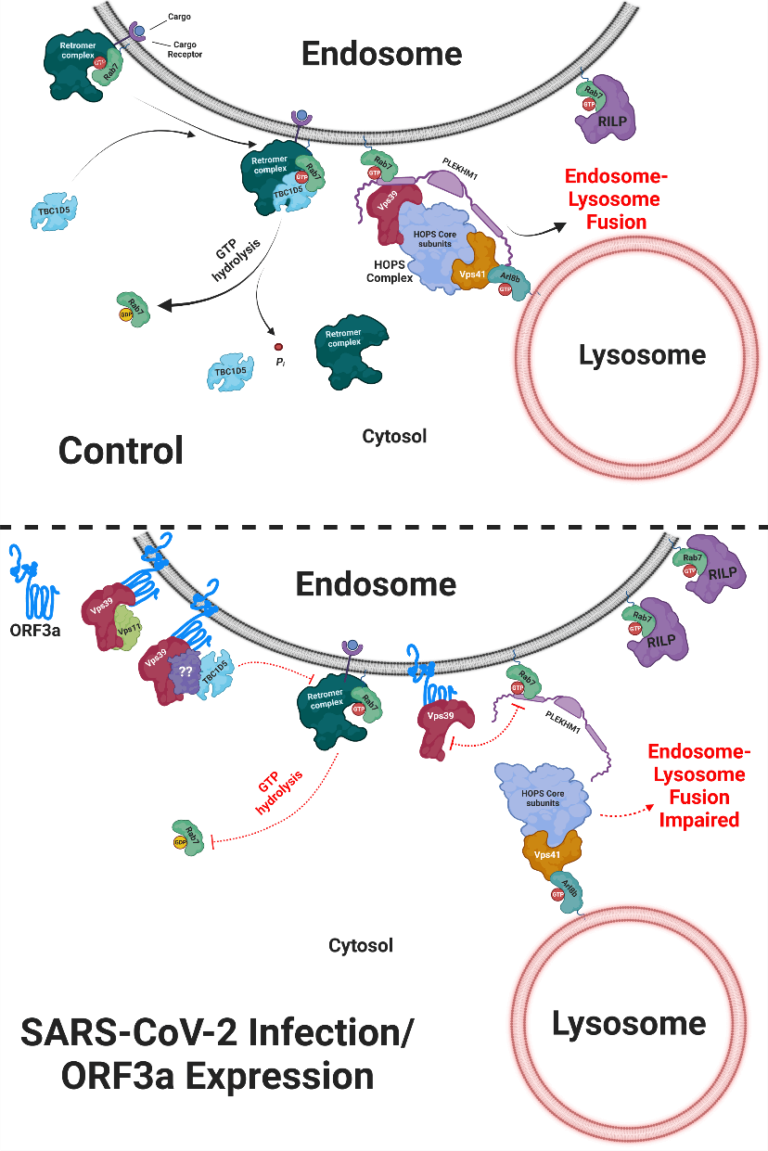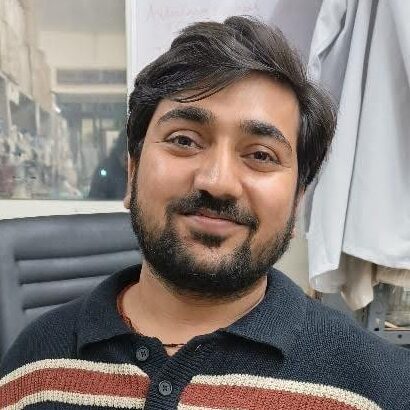SARS-CoV-2 ORF3a protein: a virulence factor that hijacks host endo-lysosomal system
Work done in the lab of Dr. Amit Tuli, Principal Scientist, at CSIR-Institute of Microbial Technology (IMTECH), Chandigarh
Kshitiz Walia is a CSIR Senior Research Fellow (PhD student) at the CSIR-Institute of Microbial Technology (IMTECH) in Chandigarh, India, working in the laboratory of Dr. Amit Tuli (Principal Scientist). He earned a master’s degree in microbiology from Maharshi Dayanand University (Department of Microbiology), Rohtak, Haryana, India. During his master’s degree, he worked under the supervision of Dr. Pooja Suneja and completed his dissertation work entitled “To characterize ACC deaminase producing endophytic bacteria and evaluate their plant growth promoting ability under salt stress”. Kshitiz is currently conducting research for his PhD thesis on “The role of small G proteins and their effectors in endo-lysosomal pathways: implications during pathogenesis”.
Author Interview
How would you explain your research outcomes to the non-scientific community?
As we know, cells are the basic unit of life and are quite comparable to an industry. For example, every industry has different departments like production, services, sales (including export of the manufactured products), etc. Similarly, every cell has different compartments that have to execute their essential cellular processes. For example, the endoplasmic reticulum and Golgi compartments produce proteins, which they then distribute to various locations to maintain cellular homeostasis. Our lab focuses on one of these cellular organelles, lysosomes, which are well known for the degradation of cellular waste and are therefore called “digestive bags.” However, research in the past few years has discovered a much more complex role for these organelles in maintaining cellular homeostasis. Lysosomes are now well-known for their role in multiple processes like nutrient sensing, autophagy, cargo degradation, plasma membrane repair, bone remodeling, immune response, and defense against pathogens, etc. Importantly, any defect in the functioning or uncontrolled functioning of lysosomes leads to various disorders, including neurodegenerative diseases like Alzheimer’s disease and Parkinson’s disease, lysosomal storage diseases like Gaucher disease and Niemann-Pick disease, and others like osteopetrosis, etc. Intracellular vesicular transport and recycling pathways form the physiologically functional arms of the host cell endosomal system, and lysosomes have a key role in the degradation and recycling of extracellular as well as intracellular material. The functions of lysosomes are controlled by different molecules, like small G proteins and their specific effector proteins, adaptor proteins, and molecular motors. Our research team is interested in understanding the mechanism and functions of these molecules, how the functions of lysosomes are controlled, what types of signals alter the distribution/positioning of lysosomes, and which factors are responsible for the proper functioning of the lysosomes. Thus, to cure disorders related to lysosomal dysfunction, we need to understand how these molecules interact with each other and operate for the proper functioning of lysosomes.
The whole world already knows that the worldwide pandemic of Coronavirus Disease 2019 (COVID-19) was caused by the novel Severe Acute Respiratory Syndrome Coronavirus (SARS-CoV-2). At the time of the pandemic, we all used to listen to news that the coronavirus forced the concerned governments to implement lockdowns in their respective countries. Also, with time, the virus undergoes multiple adaptive mutations in different proteins, which led to the emergence of multiple natural variants with different characteristics in comparison to its wild-type strain. Considering the potential effects of these variants on public health worldwide, some of these variants have been declared variants of concern (VOCs). The emergence of vaccines undoubtedly changed the course of the pandemic globally by saving many lives.
Many pathogens, from bacteria to viruses like Salmonella typhi responsible for typhoid and HIV (Human Immunodeficiency Virus) that causes AIDS (Acquired Immune Deficiency Syndrome), use intracellular vesicular sorting pathways and recycling pathways for pathogenesis to aid in their survival and infectious life cycle. Finding the mechanisms underlying the cellular processes disrupted by various pathogens is of growing interest. As discussed above, diverse host cellular factors are responsible for the functional organization of the host endosomal system. Among these, the small G-proteins, which consistently cycle between GTP-bound/active and GDP-bound/inactive states, and the tethering complex/proteins are responsible for regulating multiple cellular processes, including cargo trafficking from one compartment to another. In our recent study, we investigated how SARS-CoV-2 escapes the lysosomal degradation pathway. The current study hypothesized a key role of SARS-CoV-2 accessory factor, ORF3a, as a virulence factor, and we tried to investigate the mechanism of how ORF3a helps the virus for infection inside the host cell.

“The current study hypothesized a key role of SARS-CoV-2 accessory factor, ORF3a, as a virulence factor, and we tried to investigate the mechanism of how ORF3a helps the virus for infection inside the host cell.”
How do these findings contribute to your research area?
Our study shows that SARS-CoV-2 ORF3a is a major virulence factor that modulates and disrupts the properties and function of host late endocytic compartments by altering the activation status of small G protein, Rab7, an indispensable regulator of late endosome/lysosome positioning and functions. ORF3a impairs the fusion of late endosomes with lysosomes and rather promotes the egress of the virus via lysosomal exocytosis and supports the viral infection inside the host.
What was the exciting moment during your research?
The whole journey as a PhD student is very challenging, and this journey with setbacks and comebacks helps me grow every day. My journey in IMTECH can be easily described with the quote, “In a growth mindset, challenges are exciting rather than threatening.” Our work’s acceptance for publication in Nature Communications was the most exciting moment during this journey. Recently, our work is featured in Nature Communications Editor’s Highlights column of “Microbiology and infectious diseases”.
What do you hope to do next?
After my PhD, I’d like to continue my career as a researcher in science. I want to go for post-doctoral research in a field related to neuroscience. Also, I want to explore the field of organ regeneration, which is quite fascinating to me. Apart from this, I would like to educate young kids and assist them in learning science.
Where do you seek scientific inspiration from?
My inspiration comes from my principal investigator, Dr. Amit Tuli, my senior, Dr. Gaurav Kumar, and my colleagues. During this journey as a PhD scholar, I learned many new exciting skills, but I think I have a long journey ahead of me, and I aim to learn and contribute to the advancement of society, like Sonam Wangchuk’s invention of the glacier grafting technique (the Ice Stupa artificial glacier) for storing the winter ice melt water and thus helping farmers living in the Ladakh region of India.
How do you intend to help Indian science improve?
Science in India is growing every day, and I would like to add my contribution by guiding new researchers and helping them understand the fundamentals of science. I would like to further explore the applications of science in the healthcare industry.
Reference:
Walia, K., Sharma, A., Paul, S. et al. SARS-CoV-2 virulence factor ORF3a blocks lysosome function by modulating TBC1D5-dependent Rab7 GTPase cycle. Nature Communications 15, 2053 (2024). DOI: 10.1038/s41467-024-46417-2
A blog on the study – “Behind the Paper”: https://go.nature.com/49WSdKG
Biopatrika: Bringing Science to Society
© Biopatrika 2024 All Rights Reserved.
